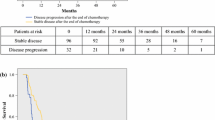Abstract
Accepted management for colorectal cancer (CRC) involves resection of the primary neoplasm and chemotherapy; the debate continues over the most beneficial order of these components. Preoperative chemotherapy aimed at liver metastases may result in complete pathologic response and replacement of the malignancy with scar. The McGill University liver diseases database was retrospectively reviewed. Fortyone patients receiving treatment between December 2003 and August 2004 were identified, their medical records examined, and liver histology reviewed. The histology of the remnants was linked to the appearance of the lesions on preresection imaging and to the primary colorectal neoplasms. Twenty-seven of the 41 patients (66%) received preoperative chemotherapy (oxaliplatin or irinotecan). Features of the primary neoplasm that predicted resolution of the metastases were absence of tumor budding (P = 0.04), absence of a diffusely infiltrative tumor margin (P = 0.02), and loss of expression of the DNA repair gene O6-methylguanine-DNA methyltransferase (P = 0.08). Oxaliplatin and irinotecan demonstrate beneficial effects in treating hepatic colorectal metastases and should be considered in such patients before resection. We propose the acronym RUMP to denote the remnants of uncertain malignant potential remaining. Further investigation is required to determine any correlation between the drug received and the resulting lesion.
Similar content being viewed by others
References
Adam R, Delvart V, Pascal G, et al. Rescue surgery for unresectable colorectal liver metastases downstaged by chemotherapy: A model to predict long-term survival. Ann Surg 2004;240:644–657.
Matsukura S, Samejima R, Tanaka M, Hidaka K. Retrospective study of irinotecan plus fluorouracil and l-leucovorin chemotherapy for advanced and metastatic colorectal cancer [in Japanese]. Gan To Kagaku Ryoho 2004;31:893–896.
Morishita Y, Kasakura Y, Fujii M, et al. A case report of colon cancer with liver and lung metastases responding to combination chemotherapy with l-LV, 5-fluorouracil and CPT-11 [in Japanese]. Gan To Kagaku Ryoho 2004;31:427–430.
Fossa SD, Aass N, Ous S, et al. Histology of neoplasm residuals after chemotherapy in patients with advanced nonseminomatous testicular cancer. J Urol 1989;142:1239–1242.
Whitehall VLJ, Walsh MD, Young J, Leggett BA, Jass JR. Methylation of O6-methylguanine DNA methyltransferase characterizes a subset of colorectal cancer with low-level DNA microsatellite instability. Cancer Res 2001;61:827–830.
Ward RL, Cheong K, Ku SL, Meagher A, O’Connor T, Hawkins NJ. Adverse prognostic effect of methylation in colorectal cancer is reversed by microsatellite instability. J Clin Oncol 2003;21:3729–3736.
Van Rijnsoever M, Elsaleh H, Joseph D, McCaul K, Iacopetta B. CpG island methylator phenotype is an independent predictor of survival benefit from 5-fluorouracil in stage III colorectal cancer. Clin Cancer Res 2003;9:2898–2903.
Nagasaka T, Sharp GB, Notohara K, et al. Hypermethylation of O6-methylguanine-DNA methyltransferase promoter may predict nonrecurrence after chemotherapy in colorectal cancer cases. Clin Cancer Res 2003;9:5306–5312.
Greenson JK, Bonner JD, Ben-Yzhak O, et al. Phenotype of microsatellite unstable colorectal carcinomas: Well-differentiated and focally mucinous neoplasms and the absence of dirty necrosis correlate with microsatellite instability. Am J Surg Pathol 2003;27:563–570.
Ueno H, Murphy J, Jass JR, Mochizuki H, Talbot IC. Neoplasm "budding" as an index to estimate the potential of aggressiveness in rectal cancer. Histopathology 2002;40:127–132.
Rougier P, Guimbaud R, Mitry E, Vaillant JN. Chemotherapy with curative intent before (neoadjuvant) or after (adjuvant) surgery for colorectal cancer liver metastases. Bull Acad Natl Med 2003;187:881–892.
Elias D, Youssef O, Sideris L, et al. Evolution of missing colorectal liver metastases after inductive chemotherapy and hepatectomy. J Surg Oncol 2004;86:4–9.
Ong SY. Neoadjuvant chemotherapy in the management of colorectal metastases: A review of the literature. Ann Acad Med Singapore 2003;32:205–211.
Bismuth H, Adam R, Levi F, et al. Resection of nonresectable liver metastases from colorectal cancer after neoadjuvant chemotherapy. Ann Surg 1996;224:509–520.
Frena A, Martin F, La Guardia G, et al. Liver resection after downstaging with neoadjuvant chemotherapy for "unresectable" colorectal metastases [in Italian]. Chir Ital 2004;56:351–357.
Adam R, Avisar E, Ariche A, et al. Five-Year survival after hepatic resection after neoadjuvant therapy for nonresectable colorectal [liver] metastases. Ann Surg Oncol 2001;8:347–353.
Parikh AA, Gentner B, Wu TT, Curley SA, Ellis LM, Vauthey JN. Perioperative complications in patients undergoing major liver resection with or without neoadjuvant chemotherapy. J Gastrointest Surg 2003;7:1082–1088.
Lorenz M, Staib-Sebler E, Gog C, et al. Prospective pilot study of neoadjuvant chemotherapy with 5-fluorouracil, folinic acid and oxaliplatin in resectable liver metastases of colorectal cancer. Analysis of 42 neoadjuvant chemotherapies. Zentralbl Chir 2003;128:87–94.
Wein A, Riedel C, Bruckl W, et al. Neoadjuvant treatment with weekly high-dose 5-fluorouracil as 24-hour infusion, folinic acid and oxaliplatin in patients with primary respectable liver metastases of colorectal cancer. Oncology 2003;64:131–138.
Jass JR, Barker M, Fraser L, et al. APC mutation and neoplasm budding in colorectal cancer. J Clin Pathol 2003;56:69–73.
Weinstein RS, Jakate SM, Dominguez JM, et al. Relationship of the expression of the multidrug resistance gene product (P-glycoprotein) in human colon carcinoma to local aggressiveness and lymph node metastasis. Cancer Res 1991; 51:2720–2726.
Nagtegaal I, Gaspar C, Marijnen C, Van De Velde C, Fodde R, Van Krieken H. Morphological changes in neoplasm type after radiotherapy are accompanied by changes in gene expression profile but not in clinical behaviour. J Pathol 2004;204:183–192.
Amaya K, Nishimura G, Sasaki S, et al. Four cases of multiple liver metastasis of colorectal cancer treated with hepatic resection after chemotherapy [in Japanese]. Gan To Kagaku Ryoho 2001;28:1768–1771.
Author information
Authors and Affiliations
Rights and permissions
About this article
Cite this article
Znajda, T.L., Hayashi, S., Horton, P.J. et al. Postchemotherapy characteristics of hepatic colorectal metastases: remnants of uncertain malignant potential. Journal of Gastrointestinal Surgery 10, 483–489 (2006). https://doi.org/10.1016/j.gassur.2006.01.002
Issue Date:
DOI: https://doi.org/10.1016/j.gassur.2006.01.002




